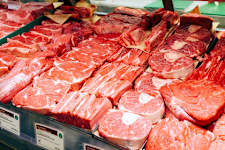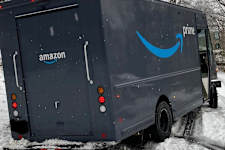A major warmup will be accompanied by widespread rain that could cause disruptions and more travel headaches across the East Coast in the final days of 2022.
By Alex Sosnowski, AccuWeather senior meteorologist
Published Dec 28, 2022 12:33 PM EST | Updated Dec 28, 2022 12:49 PM EST
A quick-moving storm will accompany a major warmup in the eastern United States during the last few days of 2022 and into the start of 2023. While the storm will bring mostly rain versus snow and ice, wet roads and low visibility can pose some problems for motorists and airlines, AccuWeather meteorologists warn.
"A storm is expected to draw warm, moist air northward through the eastern third of the nation this holiday weekend, and the result will be a soaking rainfall for more than 100 million people," AccuWeather Senior Meteorologist Brett Anderson said.
Areas of low clouds and drizzle in parts of eastern Texas, Louisiana, Mississippi and Arkansas will evolve into rain and thunderstorms and expand eastward toward the Florida Panhandle and northward to the Ohio Valley from Wednesday night into Friday. Travel slowdowns will expand in the Interstate 10, 20, 40 and 55 corridors with slick roads and ponding in poor drainage areas as a result. The wet weather, includes Houston, New Orleans and Nashville.

The bulk of the rain across the southeastern U.S. is expected from Friday night to Saturday, with the potential for a general 1-2 inches to fall. The heaviest rain is likely to fall in an area stretching from the Florida Panhandle through the Carolinas, which may lead to localized flooding in poor drainage areas.
Thunderstorms may produce torrential rainfall at the local level, especially close to the Gulf Coast, which can greatly reduce visibility and lead to pockets of flash flooding, Anderson stated.
"The combination of the rain and low ceiling may lead to some travel disruptions at major airports such as Atlanta and Charlotte," Anderson said.
Drenching rain will spread over the Midwest hubs of Cincinnati and Detroit on Friday night, when delays may ramp up. The bulk of the rain is likely to stay to the east of Chicago and St. Louis with only a few showers and spotty drizzle likely, forecasters say.

Most of the rain in the Northeast is expected Saturday night into early Sunday morning, with the heaviest rainfall expected along the I-95 corridor.
"In the northern states, as the warmer and moist air moves over the colder and, in some spots, snow-covered ground, the result will be widespread fog, which may make travel difficult at times," Anderson said. In some cases, the visibility can drop to near zero.
Ground stops may be issued at airports where dense fog develops, which can have a ripple effect at airports across the nation.
"Anyone planning on flying into or out of airports from Michigan and Ohio eastward this weekend should check ahead with their airlines as fog and low ceilings may disrupt flight schedules," Anderson warned. This includes the major hubs of Detroit, New York City, Philadelphia, Washington, D.C., Pittsburgh, and Boston.

Motorists should consider allowing extra time for their communities. Folks who are driving through foggy areas should reduce their vehicle speed, while those who are driving on wet roads should maintain a safe distance away from the vehicle ahead of them as stopping on a wet road requires more distance than on dry pavement.
Even though less rain will fall in parts of the Midwest and Northeast, relative to near the Gulf coast, the combination of drenching rain and especially piles of snow that may be blocking storm drains can lead to street flooding.
Since much of the snow blew off roofs in the eastern Great Lakes region during the deadly lake-effect blizzard during the Christmas weekend, as recovery and cleanup operations continue, a few problems from roof collapses are likely. However, where deep drifts remain on some flat roofs, the added weight from the rain can be enough to cause damage.
"Unfortunately, it looks like many of the New Year's Eve celebrations Saturday night will be wet with reduced visibility, but at least it will not be terribly cold," Anderson said. Rain is likely to soak revelers in Times Square in Manhattan Saturday evening. The rain should exit Philadelphia Sunday morning before the annual Mummers Parade takes place.

The storm will be accompanied by temperatures in the 40s and 50s F in much of the Northeast and the 60s and 70s in the Southeast, which is more typical of March or April.
The air that follows the storm will not be all that cold. Arctic air will be pent up in Canada. Some minor lake-effect snow may develop for a brief time from New Year's Day to Sunday night off lakes Erie and Ontario, but it will be a drop in the bucket compared to the massive snow that fell on Buffalo and other communities during the Christmas weekend.

For snow lovers along the I-95 corridor hoping for the big storm, there are no signs of the weather answering the call anytime soon.
It may take until the second week of January at the earliest before enough cold air is able to move in for any storm to have a chance of bringing snow to the Atlantic coast, AccuWeather Lead Long-Range Meteorologist Paul Pastelok said.
"The jet stream pattern may amplify enough from Jan. 7-14 to allow one of three storms to attempt to bring snow to the Eastern Seaboard, but that is far from a guarantee at this point," Pastelok said. "Atlantic water temperatures are still quite warm and could force a storm to track well to the west with rain on the coast."
Snow could have an easier time returning to portions of the Appalachians, Midwest and Plains in early January.
The next major storm that could have widespread impacts for snow and severe weather in the central U.S. will be as soon as early next week.
More to read:
Want next-level safety, ad-free? Unlock advanced, hyperlocal severe weather alerts when you subscribe to Premium+ on the AccuWeather app. AccuWeather Alerts™ are prompted by our expert meteorologists who monitor and analyze dangerous weather risks 24/7 to keep you and your family safer.







No comments:
Post a Comment